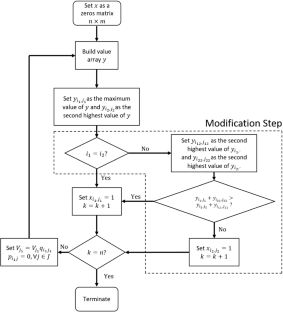Abstract
The weapon target assignment (WTA) problem, which has received much attention in the literature and is of continuing relevance, seeks within an air defense context to assign interceptors (weapons) to incoming missiles (targets) to maximize the probability of destroying the missiles. Kline et al. (J Heuristics 25:1–21, 2018) developed a heuristic algorithm based upon the solution to the Quiz Problem to solve the WTA. This heuristic found solutions within 6% of optimal, on average, for smaller problem instances and, when compared to a leading WTA heuristic from the literature, identified superlative solutions for larger instances within hundredths of a second, in lieu of minutes or hours of computational effort. Herein, we propose and test an improvement to the aforementioned heuristic, wherein a modified implementation iteratively blocks exiting assignments to an initial feasible solution, allowing superior solutions that would otherwise be prevented via a greedy selection process to be found. We compare these results to the optimal solutions as reported by a leading global optimization solver (i.e., BARON) and find solutions that are, at worst, within 2% of optimality and, at best, up to 64% better than the solutions reported to be optimal by BARON. To wit, the developed metaheuristic outperformed BARON in 25% of all instances tested, as BARON reported a suboptimal solution as being optimal for 21.1% of the instances, and it could not identify an optimal solution for the remaining 6.67% of the instances within 2 h of CPU time, a liberally imposed time limit that far exceeds practical usage considerations for this application.



Similar content being viewed by others
References
Ahner, D.K.: Planning and control of unmanned aerial vehicles in a stochastic environment. Doctor of Philosophy dissertation, Boston University (2005)
Ahuja, R.K., Kumar, A., Jha, K.C., Orlin, J.B.: Exact and heuristic algorithms for the weapon-target assignment problem. Oper. Res. 55(6), 1136–1146 (2007)
BARON Publications: The Optimization Firm. BARON Publications. http://www.minlp.com/baron-publications (2018)
Bertsekas, D.P., Castañon, D.A.: Rollout algorithms for stochastic scheduling problems. J. Heuristics 5(1), 89–108 (1999)
Chang, S.C., James, R.M., Shaw, J.J.: Assignment algorithm for kinetic energy weapons in boost phase defense. In: 26th IEEE Conference on Decision and Control, vol. 26, pp. 1678–1683. IEEE (1987)
Couenne (2016) Couenne, an Exact Solver for Nonconvex MINLPs. https://projects.coin-or.org/Couenne
den Broeder, G., Ellison, R., Emerling, L.: On optimum target assignments. Oper. Res. 7(3), 322–326 (1959)
Johansson, F., Falkman, G.: An empirical investigation of the static weapon-target allocation problem. In: Proceedings of the 3rd Skövde Workshop on Information Fusion Topics (SWIFT2009), Sweden (2009)
Kline, A.G., Ahner, D.K., Lunday, B.J.: Real-time heuristic algorithms for the static weapon target assignment problem. J. Heuristics 25, 1–21 (2018)
Kolitz, S.E.: Analysis of a maximum marginal return assignment algorithm. In: Proceedings of the 27th IEEE Conference on Decision and Control, pp 2431–2436. IEEE (1988)
Kristensen, H.M.: Norris RS (2018) Chinese nuclear forces. Bull. At. Sci. 74(4), 289–295 (2018)
Kwon, O., Kang, D., Lee, K., Park, S.: Lagrangian relaxation approach to the targeting problem. Naval Res. Logist. 46(6), 640–653 (1999)
Lastusilta, T., Bussieck, M.R., Westerlund, T.: An experimental study of the gams/alphaecp minlp solver. Ind. Eng. Chem. Res. 48(15), 7337–7345 (2009)
Lee, Z.J., Lee, C.Y., Su, S.F.: An immunity-based ant colony optimization algorithm for solving weapon-target assignment problem. Appl. Soft Comput. 2(1), 39–47 (2002a)
Lee, Z.J., Su, S.F., Lee, C.Y.: A genetic algorithm with domain knowledge for weapon-target assignment problems. J. Chin. Inst. Eng. 25(3), 287–295 (2002b)
Lee, Z.J., Su, S.F., Lee, C.Y.: Efficiently solving general weapon-target assignment problem by genetic algorithms with greedy eugenics. IEEE Trans. Syst. Man Cybern. Part B (Cybern.) 33(1), 113–121 (2003)
LINDO: Global Solver Tab. https://www.lindo.com/doc/online_help/ lingo17_0/index.html?global_solver_tab.htm (2019)
Lloyd, S.P., Witsenhausen, H.S.: Weapons allocation is NP-complete. In: 1986 Summer Computer Simulation Conference, pp. 1054–1058 (1986)
Manne, A.S.: A target-assignment problem. Oper. Res. 6(3), 346–351 (1958)
Neumaier, A., Shcherbina, O., Huyer, W., Vinkó, T.: A comparison of complete global optimization solvers. Math. Program. 103(2), 335–356 (2005)
SCIP (2019) Scip optimization suite. what is SCIP? https://scip.zib.de/index.php# scipoptsuite
Shang, G., Zaiyue, Z., Xiaoru, Z., Cungen, C.: Immune genetic algorithm for weapon-target assignment problem. In: Workshop on Intelligent Information Technology Application, pp. 145–148. IEEE (2007)
Wacholder, E.: A neural network-based optimization algorithm for the static weapon-target assignment problem. ORSA J. Comput. 1(4), 232–246 (1989)
Zeng, X., Zhu, Y., Nan, L., Hu, K., Niu, B., He, X.: Solving weapon-target assignment problem using discrete particle swarm optimization. In: The Sixth World Congress on Intelligent Control and Automation, 2006. WCICA 2006, vol. 1, pp. 3562–3565. IEEE (2006)
Acknowledgements
The authors gratefully thank the Area Editor, the Associate Editor, and an anonymous reviewer for their constructive comments that helped improve the presentation of this paper.
Author information
Authors and Affiliations
Corresponding author
Additional information
Publisher's Note
Springer Nature remains neutral with regard to jurisdictional claims in published maps and institutional affiliations.
Rights and permissions
About this article
Cite this article
Kline, A.G., Ahner, D.K. & Lunday, B.J. A heuristic and metaheuristic approach to the static weapon target assignment problem. J Glob Optim 78, 791–812 (2020). https://doi.org/10.1007/s10898-020-00938-4
Received:
Accepted:
Published:
Issue Date:
DOI: https://doi.org/10.1007/s10898-020-00938-4




